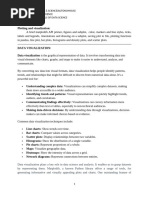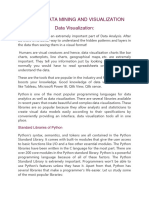Data Visualization With Python
Uploaded by
Diego RodríguezData Visualization With Python
Uploaded by
Diego Rodríguez15.
003 Software Tools — Data Science Afshine Amidi & Shervine Amidi
Type Command Illustration
Study Guide: Data Visualization with Python
Box sns.boxplot(
x, y, params
Afshine Amidi and Shervine Amidi plot
)
August 21, 2020
sns.heatmap(
General structure Heatmap
data, params
)
r Overview – The general structure of the code that is used to plot figures is as follows:
Python
# Plot
f, ax = plt.subplots(...) where the meaning of parameters are summarized in the table below:
ax = sns...
# Legend Command Description Use case
plt.title()
plt.xlabel() hue Color of a line / point / border ’red’
plt.ylabel()
fill Color of an area ’red’
We note that the plt.subplots() command enables to specify the figure size. size Size of a line / point 4
r Basic plots – The main basic plots are summarized in the table below: linetype Shape of a line ’dashed’
alpha Transparency, between 0 and 1 0.3
Type Command Illustration
Scatter sns.scatterplot(
x, y, params
plot Advanced features
)
r Text annotation – Plots can have text annotations with the following commands:
sns.lineplot( Type Command Illustration
Line
x, y, params
plot
)
ax.text(
Text x, y, s, color
)
Bar sns.barplot(
x, y, params
chart
)
r Additional elements – We can add objects on the plot with the following commands:
Massachusetts Institute of Technology 1 https://www.mit.edu/~amidi
15.003 Software Tools — Data Science Afshine Amidi & Shervine Amidi
Type Command Illustration
ax.axvline(
x, ymin, ymax, color,
linewidth, linestyle
)
Line
ax.axhline(
y, xmin, xmax, color,
linewidth, linestyle
)
r Double axes – A plot can have more than one axis with the plt.twinx() command. It is
done as follows:
Python
ax.axvspan(
ax2 = plt.twinx()
Rectangle xmin, xmax, ymin, ymax,
color, fill, alpha
) r Figure saving – There are two main steps to save a plot:
• Specifying the width and height of the plot when declaring the figure:
Python
f, ax = plt.subplots(1, figsize=(width, height))
• Saving the figure itself:
Last touch Python
f.savefig(fname)
r Legend – The title of legends can be customized to the plot with the commands summarized
below:
Element Command
ax.set_title(’text’, loc, pad)
Title / subtitle of the plot
plt.suptitle(’text’, x, y, size, ha)
Title of the x / y axis ax.set_xlabel(’text’) / ax.set_ylabel(’text’)
Title of the size / color ax.get_legend_handles_labels()
Caption of the plot ax.text(’text’, x, y, fontsize)
This results in the following plot:
Massachusetts Institute of Technology 2 https://www.mit.edu/~amidi
You might also like
- Practical Guide To Matplotlib For Data Science - 1689973407325No ratings yetPractical Guide To Matplotlib For Data Science - 168997340732535 pages
- Unit I: Data Handling Using Pandas and Data Visualization: Marks:25No ratings yetUnit I: Data Handling Using Pandas and Data Visualization: Marks:2597 pages
- Notes9_Class_10_Data Visualization using MatPlotlib NotesNo ratings yetNotes9_Class_10_Data Visualization using MatPlotlib Notes5 pages
- Data Science With Python - Lesson 10 - Data Visualization in Python With Matplotlib - RawNo ratings yetData Science With Python - Lesson 10 - Data Visualization in Python With Matplotlib - Raw71 pages
- BTech_5_CSE_Data_Analytics_Using_Python_Unit_5_NotesNo ratings yetBTech_5_CSE_Data_Analytics_Using_Python_Unit_5_Notes9 pages
- Practical Guide To Matplotlib For Data Science100% (1)Practical Guide To Matplotlib For Data Science35 pages
- Class 1 Data Visualization in Python using matplotlibNo ratings yetClass 1 Data Visualization in Python using matplotlib13 pages
- Beginners Python Cheat Sheet PCC Matplotlib PDFNo ratings yetBeginners Python Cheat Sheet PCC Matplotlib PDF2 pages
- Data Exploration & Visualization - Unit 2No ratings yetData Exploration & Visualization - Unit 28 pages
- Graphs with MATLAB (Taken from "MATLAB for Beginners: A Gentle Approach")From EverandGraphs with MATLAB (Taken from "MATLAB for Beginners: A Gentle Approach")4/5 (2)
- Henry R. Kang Computational Color Technology SPIE Press Monograph Vol. PM159 0100% (1)Henry R. Kang Computational Color Technology SPIE Press Monograph Vol. PM159 0511 pages
- VESCinematicColor From Your Monitor To The Big ScreenNo ratings yetVESCinematicColor From Your Monitor To The Big Screen54 pages
- The Ultimate Guide To Create Brand IdentityNo ratings yetThe Ultimate Guide To Create Brand Identity26 pages
- Law Center PowerPoint Template by SlideWinNo ratings yetLaw Center PowerPoint Template by SlideWin29 pages
- Edinburgh University Press Style SheetsNo ratings yetEdinburgh University Press Style Sheets12 pages
- Character Design Issue - Vektorika Magazine 10 PDF100% (1)Character Design Issue - Vektorika Magazine 10 PDF59 pages
- Long Test in English 9quarter 1 Week 3 4No ratings yetLong Test in English 9quarter 1 Week 3 43 pages
- Price List - Marine Coating - Kalimantan - Jan-Jun 2025No ratings yetPrice List - Marine Coating - Kalimantan - Jan-Jun 20252 pages
- Resume and Portfolio Small Timothy GeldardNo ratings yetResume and Portfolio Small Timothy Geldard13 pages
- E Engineering Graphics and Design Grade 12 - 3rd Angle Castings Worksheets - LessonNo ratings yetE Engineering Graphics and Design Grade 12 - 3rd Angle Castings Worksheets - Lesson31 pages





























































































